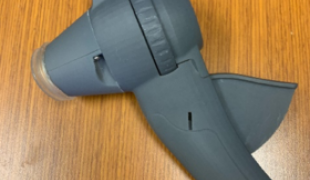- 6717
- 519
- 8
- 8
- 0
- Help Ukraine
About the solution
Julio Vazquez’s friend, Rami Wehbe, had a cerebrovascular accident, also known as a stroke. This happens when blood flow to a certain part of the brain is stopped, either by a blockage or by the rupture of a blood vessel.
Due to this, Rami was unable to use his right hand to play Zelda, a famous fantasy action-adventure video game.
This inspired Julio to invent a solution that would allow his friend to play using only his left hand.
First, Julio had created a prototype that simply squished the two joy-cons together so that the space that normally exists between them disappears, making it easier to use with just one hand, as one thumb can reach every point of the controller.
After that, he developed a more elaborate model which joins the joy-cons together in a way that allows the player to use the thumb on one side and the other fingers on the other side of the controller. To allow this, the joy-con single hand adapter has a right-angle design, which accommodates smaller hands too. Julio used 3-D printing for the design.
"This current design was the result of almost a week of research and lots of failed prototypes, as I had to ensure that it would be easy to print, lightweight and practical”, Julio said.
He then decided to share it so he could help other people who, like his friend, can only use one hand.
Blueprints for the models can be obtained on the webpage ‘Thingiverse’ and peripherals can be printed at a local 3-D printing shop.
Adapted from: http://bit.ly/2kyv8Ll
More info: http://bit.ly/2lJkOjK
这些解决方案不应包括使用药物,化学品或生物制品(包括食品);创伤性设备;冒犯性的,商业或内在危险的内容。该解决方案未经医学验证。请谨慎进行!如果您有任何疑问,请咨询健康专家。
DISCLAIMER: This story was written by someone who is not the author of the solution, therefore please be advised that, although it was written with the utmost respect for the innovation and the innovator, there can be some incorrect statements. If you find any errors please contact the patient Innovation team via info@patient-innovation.com
-
-
416
-
0
-
6096

Device to help get out of the car
Grip
STANDING UP: Standing up from a seated position
Arthritis
Muscle Tone Abnormalities weakness
3d Printed
Assistive Daily Life Device (to help ADL)
Difficulty walking or moving
Muscle weakness
Limited range of motion
Muscle pain or stiffness
Loss of muscle coordination
Muscle cramps or spasms
Joint redness or warmth
Swelling or inflammation
Difficulty standing from a seated position
Back pain
Joint pain or swelling
Restoring mobility
Managing pain
Caregiving Support
General and Family Medicine
Neurology
Orthopedics
Public Health
Rheumatology
Aging
Mobility issues
Belgium
-
-
-
277
-
3
-
3251

Student develops special games controller for his sister
Grip
Video gaming
Cerebral Palsy
Neuromuscular Disorders
3d Printed
App (Including when connected with wearable)
Muscle cramps or spasms
Difficulty coordinating movements
Stiffness or rigidity (difficulty moving)
Paralysis of the legs and lower body
Muscle weakness
Managing Neurological Disorders
Promoting inclusivity and social integration
Caregiving Support
Neurology
United Kingdom
-
-
-
318
-
0
-
4394

Nurse develops device that makes using eyedrops easier
CAREGIVING
Parkinson's Disease
5 Senses support devices: (glasses, hearing aids, headphones...)
3d Printed
Vision problems
Tremors
Muscle cramps or spasms
Stiffness or rigidity (difficulty moving)
Muscle weakness
Loss of balance
Trouble with fine motor skills (e.g., writing, buttoning clothes)
Numbness or tingling in the extremities
Twitching or involuntary movements (myoclonus)
Promoting self-management
Manage Medication
To improve Treatment/Therapy
Caregiving Support
General and Family Medicine
Neurology
Physical Medicine and Rehabilitation
United States
-
 zh
zh